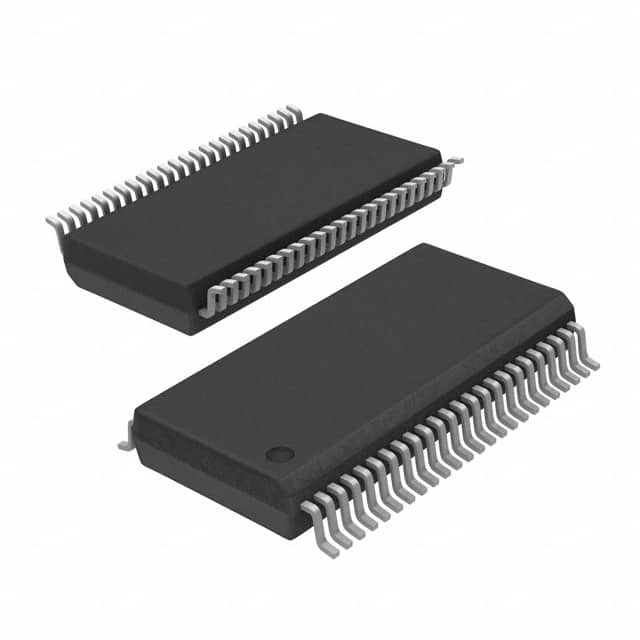Viz Specifikace pro podrobnosti o produktu.

SN74ALVC164245DL
Product Overview
Category: Integrated Circuit (IC)
Use: The SN74ALVC164245DL is a 16-bit bus transceiver with 3-state outputs. It is designed to provide bidirectional level shifting between a 3.3V bus and a 5V bus in mixed-voltage systems.
Characteristics: - Bidirectional voltage translation - Supports both 3.3V and 5V systems - 16-bit wide data path - 3-state outputs for bus sharing - Low power consumption - High-speed operation
Package: The SN74ALVC164245DL is available in a dual in-line package (DIP) with 48 pins. The package provides easy integration into circuit boards and ensures reliable connections.
Essence: This IC acts as a bridge between two buses operating at different voltage levels, enabling seamless communication between them.
Packaging/Quantity: The SN74ALVC164245DL is typically sold in reels or tubes, containing multiple units per package. The exact quantity may vary depending on the supplier.
Specifications
- Supply Voltage Range: 2.3V to 3.6V (VCCA), 4.5V to 5.5V (VCCB)
- Input Voltage Range: -0.5V to VCCA + 0.5V (VI)
- Output Voltage Range: -0.5V to VCCB + 0.5V (VO)
- Operating Temperature Range: -40°C to +85°C
- Propagation Delay: 3.8ns (Max)
- Output Current: ±24mA
Detailed Pin Configuration
The SN74ALVC164245DL has 48 pins, which are divided into four groups:
- Group A (pins 1-12): A-side data inputs/outputs (D1-D12)
- Group B (pins 13-24): B-side data inputs/outputs (D13-D24)
- Group C (pins 25-36): Control inputs (OEAB, OEBA, DIR)
- Group D (pins 37-48): Power supply and ground pins (VCCA, VCCB, GND)
For a detailed pin configuration diagram, please refer to the datasheet provided by the manufacturer.
Functional Features
- Bidirectional data transfer: The SN74ALVC164245DL allows data to be transmitted bidirectionally between the A-side and B-side buses.
- Voltage translation: It provides level shifting between a 3.3V bus and a 5V bus, ensuring compatibility between different voltage systems.
- 3-state outputs: The IC supports bus sharing by enabling the outputs to be put in a high-impedance state when not actively transmitting data.
- High-speed operation: With a maximum propagation delay of 3.8ns, it ensures efficient data transfer between the buses.
Advantages and Disadvantages
Advantages: - Enables seamless communication between 3.3V and 5V buses - Low power consumption - Supports high-speed data transfer - Provides bidirectional voltage translation - Allows for bus sharing with 3-state outputs
Disadvantages: - Limited to 16-bit data path - Requires careful consideration of voltage levels to avoid signal degradation
Working Principles
The SN74ALVC164245DL utilizes a combination of transistors and logic gates to achieve bidirectional voltage translation. When the control inputs are appropriately set, the IC allows data to flow bidirectionally between the A-side and B-side buses. The 3-state outputs enable multiple devices to share the same bus without interfering with each other.
Detailed Application Field Plans
The SN74ALVC164245DL finds applications in various fields, including:
- Microcontrollers: It facilitates communication between microcontrollers operating at different voltage levels.
- Industrial automation: Enables data exchange between control systems with varying voltage requirements.
- Communication systems: Used for level shifting in mixed-voltage interfaces of communication modules.
- Automotive electronics: Facilitates communication between different subsystems within a vehicle.
Detailed and Complete Alternative Models
- SN74LVC164245: Similar to SN74ALVC164245DL but operates at 3.3V only.
- SN74HCT164245: Provides bidirectional voltage translation between 5V and 3.3V buses using HCT logic family.
- SN74LVCH164245A: Offers low-voltage CMOS compatibility and bidirectional level shifting capabilities.
These alternative models provide similar functionality to the SN74ALVC164245DL but may have differences in voltage ranges, power consumption, or speed characteristics.
*Note: The above information is based on the available documentation and specifications provided by the manufacturer. It
Seznam 10 běžných otázek a odpovědí souvisejících s aplikací SN74ALVC164245DL v technických řešeních
Sure! Here are 10 common questions and answers related to the application of SN74ALVC164245DL:
Q: What is SN74ALVC164245DL? A: SN74ALVC164245DL is a 16-bit bus transceiver with 3-state outputs, designed for asynchronous communication between two data buses.
Q: What is the voltage range supported by SN74ALVC164245DL? A: SN74ALVC164245DL supports a voltage range of 1.65V to 3.6V.
Q: Can SN74ALVC164245DL be used for level shifting between different voltage domains? A: Yes, SN74ALVC164245DL can be used for level shifting between voltage domains as long as they fall within the supported voltage range.
Q: How many data lines can SN74ALVC164245DL handle? A: SN74ALVC164245DL can handle 16 bidirectional data lines.
Q: Does SN74ALVC164245DL support 3-state outputs? A: Yes, SN74ALVC164245DL supports 3-state outputs, allowing multiple devices to share a common bus.
Q: What is the maximum data transfer rate supported by SN74ALVC164245DL? A: SN74ALVC164245DL supports high-speed data transfer rates up to 400 Mbps.
Q: Can SN74ALVC164245DL be used in both parallel and serial communication systems? A: Yes, SN74ALVC164245DL can be used in both parallel and serial communication systems, depending on the application requirements.
Q: Is SN74ALVC164245DL compatible with other logic families? A: SN74ALVC164245DL is compatible with a wide range of logic families, including TTL, CMOS, and LVCMOS.
Q: Can SN74ALVC164245DL be used in automotive applications? A: Yes, SN74ALVC164245DL is suitable for automotive applications as it meets the necessary standards and requirements.
Q: Are there any specific precautions to consider when using SN74ALVC164245DL? A: It is important to follow the recommended operating conditions, such as voltage levels and temperature ranges, provided in the datasheet for optimal performance and reliability.
Please note that these answers are general and may vary depending on the specific application and requirements. Always refer to the datasheet and consult with technical experts for accurate information.

